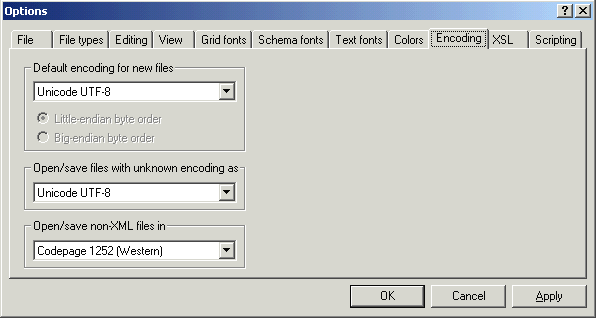The "Encoding" tab specifies the kind of character-set encoding to be used when creating new files, as well as the encoding to be assumed, when opening files that lack an encoding declaration.

Default encoding for new files
The default encoding for new files can be pre-determined in the Settings dialog box so that each new document is automatically created with a proper XML-declaration and includes the encoding-specification that you most commonly need.
The encoding for existing files will, of course, always be remembered independently of this setting and can only be changed by the "Encoding" command on the "File" menu.
If a two- or four-byte encoding is selected as the default encoding (i.e. UTF-16, UCS-2, or UCS-4) you can also choose between little-endian and big-endian byte-ordering for the XML files.
Open/save files with unknown encoding as
You can choose how an XML file is to be interpreted if the encoding-specification is missing, and the encoding cannot be auto-detected. In most cases this will very likely be UTF-8 or ISO-8895-1, even though the XML specification theoretically only allows UTF-8 files to lack an encoding-specification.
Open/save non-XML files in
Sometimes is can be convenient to also use XML Spy for editing non-XML files (such as Active Server Pages (ASP) or similar web-related documents. Since these files do not contain any encoding statements, you must specify a default Windows Code Page to be used for access these files.
Previous
Top
Next


